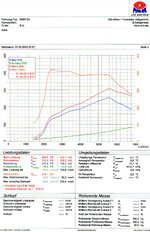Just bought my first zed a couple of weeks ago (e89 s drive 35i manual) - must say I'm absolutely loving it!
Because I live in central london I haven't needed / owned a car for a while (last one I did own was a 1.0 litre metro while at uni 7 yrs ago!) meaning I'll happilly admit i'm far from a pro when it comes to getting the most from all that power. (To be honest I'm still at the stage of uncontrollable grinning when I accelerate hard in 2nd!)
So I've been thinking - if I want to accelerate as quickly as possible, with it being a manual, what is the optimal rev count to change gear?
Theoretically, I would have thought I need to change gear at the point at which the new gear will give me more torque than the current gear. If I had torque data across the whole rev range for each of the six gears I could calculate the optimal shift in each gear (I think!)
Would welcome any thoughts you guys have on a) whether this is the right method, b) where I could get the torque data for each gear across all revs for my model and c) if I'm completely barking up the wrong tree, how I could find the best change point another way?
Thanks in advance for any help you can offer. Looking forward to posting on here more often : )
Because I live in central london I haven't needed / owned a car for a while (last one I did own was a 1.0 litre metro while at uni 7 yrs ago!) meaning I'll happilly admit i'm far from a pro when it comes to getting the most from all that power. (To be honest I'm still at the stage of uncontrollable grinning when I accelerate hard in 2nd!)
So I've been thinking - if I want to accelerate as quickly as possible, with it being a manual, what is the optimal rev count to change gear?
Theoretically, I would have thought I need to change gear at the point at which the new gear will give me more torque than the current gear. If I had torque data across the whole rev range for each of the six gears I could calculate the optimal shift in each gear (I think!)
Would welcome any thoughts you guys have on a) whether this is the right method, b) where I could get the torque data for each gear across all revs for my model and c) if I'm completely barking up the wrong tree, how I could find the best change point another way?
Thanks in advance for any help you can offer. Looking forward to posting on here more often : )
